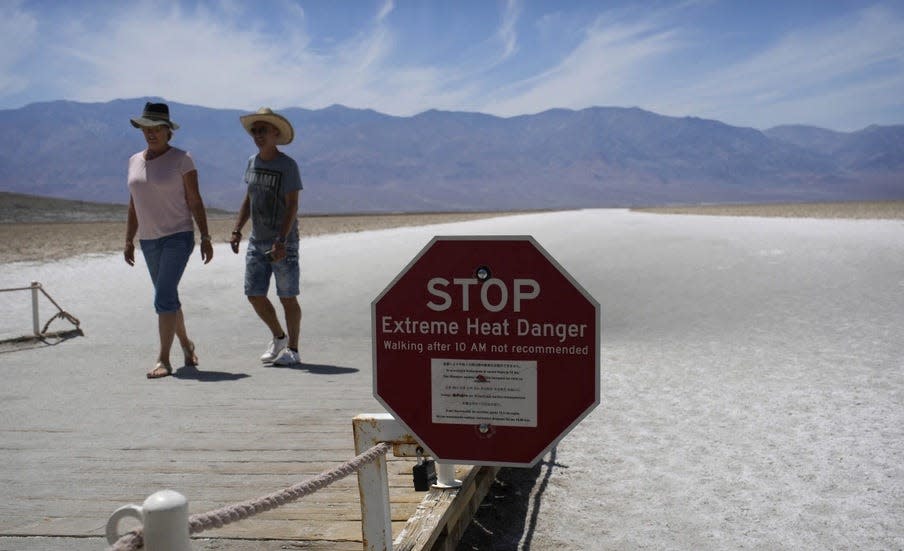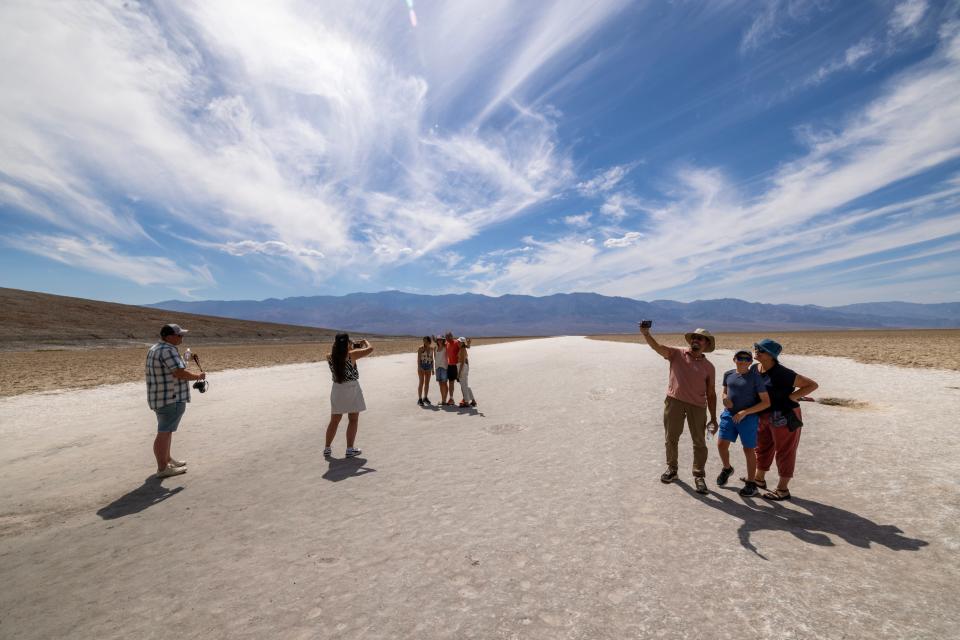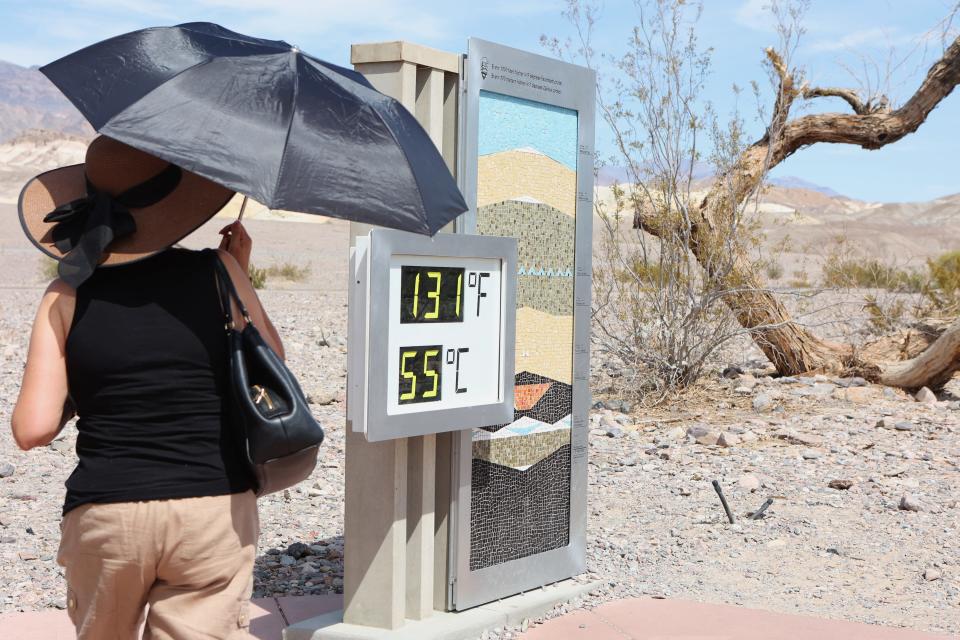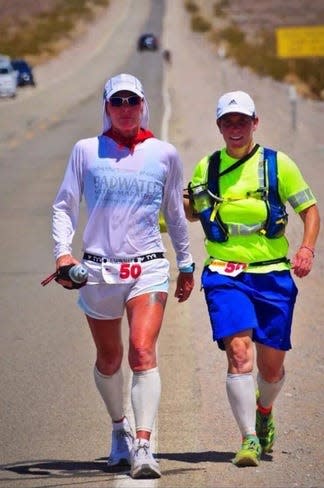Visitors beware:Two heat-related deaths reported in Death Valley

A second heat-related death this month along with throngs of visitors have Death Valley National Park officials emphasizing safety as visitors enter the park this summer.
Steven Curry, 71, of Sunland died at a trailhead in the national park on July 18 as temperatures reached the 121-degree mark.
The man collapsed outside the restroom at Golden Canyon, according to a park news release.
"National Park Service officials believe he had likely just been hiking the popular trail," park officials said. "He was wearing a sun hat and hiking clothes, and carried a backpack. His car was in the parking lot."
While his death remains under investigation, park rangers suspect “heat was a factor.”
Death Valley has experienced 28 days of temperatures over 110 degrees this year, according to the National Weather Service. Considered the hottest place on Earth, temperatures in Death Valley reached 128 degrees Fahrenheit on July 16 at Furnace Creek.

Steve Curry
Earlier in the day, Curry was interviewed by the Los Angeles Times at Zabriskie Point. He was also photographed “slathered in sunscreen, huddled beneath a metal interpretive sign that afforded a small amount of shade,” officials said.
Curry had hiked to Zabriskie Point from Golden Canyon which was about two miles away. At some point, he left the Zabriskie and hiked back to the Golden Canyon trailhead where he had parked his car, the LA Times said.
Park visitors saw Curry just before 4 p.m. and called 911, which prompted a response from the park service and Inyo County Sheriff's officials.
Park rangers performed CPR on Curry and used an automated external defibrillator, but were unable to save him.
A Mercy Air helicopter was unable to fly to the scene due to the extreme heat, officials said.
Park officials said temperatures at nearby Furnace Creek reached about 121 degrees around the time of Curry’s death, but it was likely much hotter inside Golden Canyon due to canyon walls radiating the sun's heat.

July 3 death
Park officials suspect the death of a 65-year-old man on July 3 could also be heat-related.
A park service maintenance worker noticed a vehicle about 30 yards off the road from a highway at 10 a.m. When the worker walked towards the vehicle, the employee found the man unresponsive, park officials said in a news release.
An initial investigation suggested that heat-related illness may have caused the driver to run off the road.
The man, who is from the San Diego area, was declared dead at the scene, park officials said.
“The sedan’s tracks ran along the road shoulder and rocky berm before veering further away from the paved road,” park officials said in the news release. “The vehicle did not crash.”
'Feel the heat'
Furnace Creek is an unincorporated community within Death Valley National Park. It’s also home to the park’s visitor center, which includes a digital thermometer popular with tourists.
During the second weekend in July, dozens of people gathered at the thermometer — some wearing fur coats as a joke — hoping to snap a picture with a temperature reading that would shock their friends and family.
“We’re waiting for the next heat wave and hoping it’ll push the thermometer past 130 degrees,” said Bart Matthew, 52, a self-dubbed adventurer who lives in Victorville. “We really want to feel the heat and maybe be there for a record-setting temp.”
Death Valley holds the record for the highest air temperature on the planet. On July 10, 1913, temperatures at the aptly named Furnace Creek area reached a blistering 132.1 degrees, according to the American Association for the Advancement of Science.
Temperatures at or above 130 degrees have only been recorded on Earth a handful of times, mostly in Death Valley, said Randy Ceverny, records coordinator of the World Meteorological Organization..
“With global warming, such temperatures are becoming more and more likely to occur,” Ceverny said. “Long-term: Global warming is causing higher and more frequent temperature extremes. Short-term: This particular weekend is being driven by a very very strong upper-level ridge of high pressure over the Western U.S.”

Badwater 135 Ultramarathon
Ultramarathon runner and elite endurance athlete Cheryl Zwarkowski, 65, of Victorville, knows a little something about enduring the brutal heat of Death Valley.
In 2018, Zwarkowski battled 130-degree temps to complete her eighth Badwater 135 Ultramarathon, a 135-mile foot race from Death Valley, the lowest elevation in North America, to Mt. Whitney, the highest point in the contiguous United States.
Zwarkowski finished the race in under 46 hours.
Known as the “world's toughest footrace,” the course covers three mountain ranges, with runners traveling through some places with names like Furnace Creek, Devil’s Cornfield, Devil’s Golf Course and Stovepipe Wells.
In a previous interview, Zwarkowski said that, unlike the majority of summertime visitors to Death Valley, her trip included a crew of six who supported her throughout her run.
Her crew drove a van, carried her food and fluids, and sometimes sprayed her with cold water.
Zwarkowski wore a cap and a scarf equipped with ice and constantly took in water and sodium. She also consumed at least 300 to 400 calories of carbohydrates an hour.
Many participants run on asphalt that can increase the ambient air temperature to 200 degrees, Zwarkowski said.
While the core body temperature also rises from running. They stay on the white line to minimize heat and damage to their shoes.
Safety in extreme heat
As experienced and non-experienced visitors to Death Valley flock to the park to experience extreme heat, park rangers are encouraging people to sightsee short distances from their air-conditioned cars.
Additionally, to hike in the park's cooler mountains and avoid hiking at low elevations after 10 a.m.
Additional hot weather tips include:
Drink plenty of water: Drink at least one gallon of water per day to replace loss from sweat, more if you are active. Be aware of balancing fluid and electrolyte levels.
Avoid hiking in the heat: Do not hike in low elevations when temperatures are hot. The mountains are cooler in summer but can have snow and ice in winter.
Be traveled prepared to survive: Stay on paved roads in summer. If your car breaks down, stay with it until help comes. Carry extra drinking water in your car in case of emergency.
Watch for signs of trouble: If you feel dizzy, nauseous, or have a headache, get out of the sun immediately and drink water or sports drinks. Dampen clothing to lower body temperature. Be alert for symptoms in others.
In case of emergency: Dial 911 from any telephone or cell phone. Cell phones may not work in many parts of the park. Do not depend on them.
The Associated Press contributed to this story.
Daily Press reporter Rene Ray De La Cruz may be reached at 760-951-6227 or RDeLaCruz@VVDailyPress.com. Follow him on Twitter @DP_ReneDeLaCruz
This article originally appeared on Victorville Daily Press: Visitors beware:Two heat-related deaths reported in Death Valley

